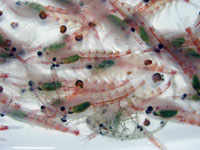|
 Krill  Enlarge image » The most obvious and abundant zooplankton in Antarctic waters are the crustaceans known as Antarctic krill, whose scientific name is Euphausia superba. (Photo courtesy of Peter Wiebe, WHOI) The most obvious and abundant zooplankton in Antarctic waters are the crustaceans known as Antarctic krill, whose scientific name is Euphausia superba. These 2 inch long pink crustaceans form swarms of millions of individuals in the water in summer. Krill swarms are the main food source for Antarctica’s large animals, including penguins, whales, fish, some seals and seabirds, and larger zooplankton. Without krill, the huge blue and fin whales might not survive. Krill live a complicated and long life, up to seven years. Their different life stages live at different depths in the ocean and collect food differently. Krill mostly eat tiny plant cells, either by catching them in open water, or scraping algae off the underside of sea ice as juveniles. The adults live in dense groups that behave like schools of fish, swimming together in ways that help them avoid and confuse their many predators. They can even shed their skin quickly when frightened, leaving a decoy ‘body’ as they dart away. Krill have been called a “bottleneck” in the ecosystem, because they are just one animal forming the link between the many kinds of tiny plankton they eat, and the many kinds of animals that eat them. This is because they are the main consumer of diatoms, while most larger animals eat krill. Great quantities of krill are also harvested every summer by humans and used for products such as fish meal. Current krill populations are smaller than they used to be, and salps may sometimes ‘out-compete’ the krill—that is, eat the food that krill would normally eat.
|
Mailing List | Feedback | Glossary | For Teachers | About Us | Contact
© 2010 Dive and Discover™. Dive and Discover™ is a registered trademark of Woods
Hole Oceanographic Institution
